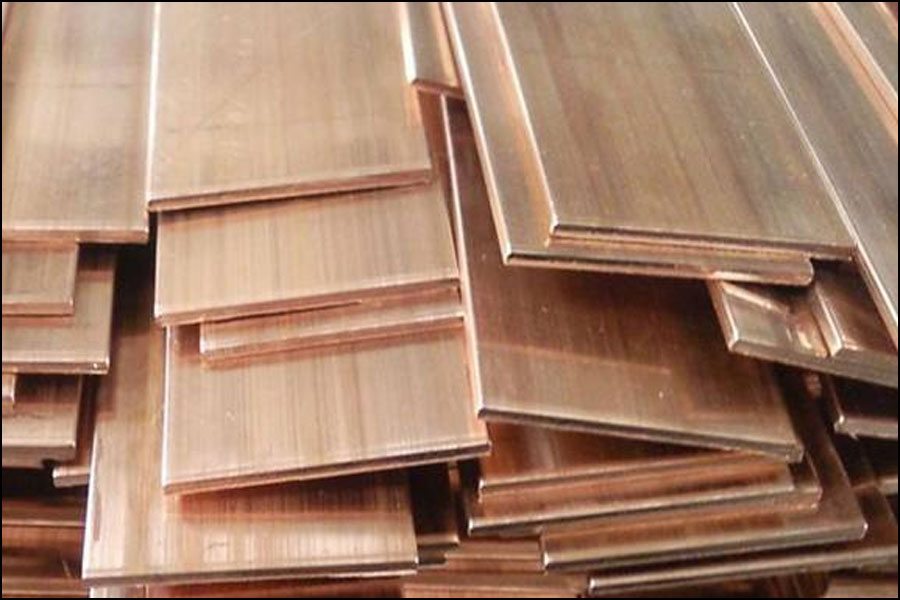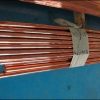
Beryllium copper, also known as beryllium bronze, is the “king of ductility” among copper alloys. After solution and aging quenching and tempering treatment, commercial high-toughness forged beryllium bronze aluminum alloy with high toughness and high conductivity can be obtained. After treatment, it not only has high toughness, high strength, and has the advantages of wear resistance and corrosion resistance, high-quality forging characteristics, beryllium bronze aluminum alloy is suitable for the production of various molds, explosion-proof safety tools, and wear-resistant materials such as camshafts , Transmission gears, worm gears, rolling bearings, etc.
Forged beryllium copper alloy with high conductivity, after quenching and tempering treatment, it has higher conductivity and heat transfer rate. Beryllium copper alloy is suitable for the production of power switch parts, strong touch and similar current-carrying components, and resistance welding machine Quick fixtures, metal electrodes and injection molds, hydropower engineering continuous casting machine mold inner pads and other beryllium transparent x-ray work ability is the strongest, known as “metal glass”, its aluminum alloy is used in airlines, aerospace, military, electronic devices , A development strategy that cannot be replaced by nuclear power generation and other industries. Metal composite material, beryllium bronze, is the most high-quality ductile aluminum alloy among alloy copper. It has excellent heat transfer, electrical conductivity, high temperature resistance, wear resistance, corrosion resistance, and no magnetic It is widely used in national defense security, instrument panel, instrument equipment, electronic computer, car, household appliances and other industrial production. The bullet yellow that works at high temperature, this type of bullet yellow still maintains stable ductility and ductility under red and hot conditions; beryllium oxide can be used as a high temperature resistant filler for high temperature thermal resistance. The raw materials for the production of explosion-proof tools have to undergo national authoritative testing Center, according to GB10686-89 no flame monitoring.
After passing the test of non-release vapor, and establishing the composition, explosion-proof grade, and impact toughness of the qualified raw materials, a written notice is issued to indicate that the explosion-proof tools announced to the customer in the official letter of the inspection report are qualified, and then they can be used with peace of mind. No type of alloy copper can be used to produce explosion-proof tools. At this stage, there are two kinds of raw materials for the production and manufacture of explosion-proof tools in the world, one is beryllium bronze aluminum alloy, the other is aluminum bronze aluminum alloy, and the other is for manufacturing explosion-proof tools. The raw materials have not been announced so far, so explosion-proof tools are not special tools. Beryllium copper is also called beryllium bronze. It is a high-quality ductile, high-conductivity, super wear-resistant, and high-toughness raw material. It has excellent ductility and pressure resistance. Strength, wear resistance, non-magnetic, non-impact flames, excellent production and machining formability under aging treatment, Tongjin also maintains the high-quality conductivity of copper-based alloys, and hits the yellow of the products supplied by Wonder alloy copper Beryllium copper is used in thousands of ductile and wear-resistant parts such as automotive relays, touch clips, injection molds, mechanical equipment, power sockets, backboards, trolleys, and hardware.
To make full use of the development potential of the characteristics of the raw materials, it is necessary to choose the standard quenching and tempering treatment method. Is the explosion-proof type of copper special tools? It is incorrect to say that the raw materials for the production of explosion-proof tools are “alloy copper” or “alloy copper”. Explosion-proof tools such as copper wrenches, copper hammers, and copper crowbars are special tools for flammable and explosive materials and steam venues. The materials are aluminum bronze, beryllium bronze, aluminum alloy, and aluminum alloy. The amount of water exceeds about 16%, and other metal materials such as iron, nickel, and manganese can be added.
Aluminum bronze has excellent tearing characteristics, high compressive strength, strength, impact resistance and fatigue. Because of this feature, it is used for pulse dampers, transmission gears and pumps. Aluminum bronze can be made into bars, plates, and plastic sheets. Strips, steel castings, etc., when aluminum alloy profiles are added to alloy copper, the percentage of aluminum produced aluminum bronze determines the grade of aluminum bronze, so that metal materials have various chemical properties. In other words, aluminum bronze is general The following effects are preserved. When the aluminum alloy profile is added to the alloy copper, the percentage of aluminum bronze produced by aluminum determines the grade of aluminum bronze, so that the metal material has a variety of different chemical properties. In other words, aluminum bronze generally preserves the following For decades, freighters and ships have used aluminum bronze aircraft propellers to avoid corrosion.
Aluminum bronze is resistant to corrosion and can resist atmospheric pollution, high temperature, ultra-low temperature and harsh organic chemistry. The corrosion of the natural environment of aluminum bronze also has microbial reliability, which means that it prevents the growth and development of microbial elements on its surface, making it a It is more beneficial to choose aluminum bronze than other non-alloyed coppers. It is characterized by high organic chemistry reliability, and is more resistant to corrosion by acid, alkali, steam and other corrosive chemicals than tin bronze; in addition, it has very good wear resistance and use performance. Malleable and castable, its compressive strength, strength and plastic deformation are beyond tin bronze.
In addition, it can also be quenched and tempered to improve its physics and physical properties, but its drawback is that the body shrinkage rate is greater than that of tin bronze, and it is very easy to cause refractory metal oxides in the castings-two Aluminum is more difficult to forge than tin bronze; the other two defects are that it cannot be welded and is unstable in over-temperature steam. Aluminum bronze is generally used in industrial production to produce key transmission gears, worm gears, bushings, and ships. Parts and other key parts that require wear and corrosion resistance. When the safety of raw materials and compressive strength are your top priorities, you can consider aluminum bronze.
This type of metal material chemical substance is particularly suitable for the metal material forging process. It has been successfully used in many manufacturing industries such as airlines, crude oil and gas, because it exceeds tin bronze in many characteristics, so it is a very good substitute for tin bronze.
The most common unique brasses are: aluminum bronze, manganese brass, silicon bronze, beryllium bronze, chromium brass and cadmium brass, etc. Among them, aluminum bronze is the most widely used in equipment manufacturing. Aluminum bronze is the best advantage One of them also includes that it can be welded by electric welding. Even after forging, this means that aluminum bronze is a distinctive metal material that can be welded safely and reasonably in time. In many situations, aluminum bronze parts do not even need to be disassembled Fixed aluminum bronze is used in many manufacturing industries, because it is not easy to cause flames under all conditions.






